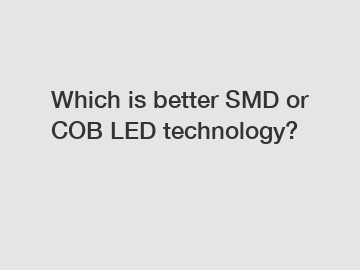Which is better SMD or COB LED technology?
Which is better: SMD or COB LED technology?
LED technology has revolutionized the lighting industry, offering numerous advantages over traditional lighting solutions. Within the LED industry, two popular technologies are widely used: Surface Mount Device (SMD) and Chip-on-Board (COB). Both SMD and COB LEDs have their own set of benefits and drawbacks, making it important for consumers and professionals alike to understand which technology suits their needs best.
Advantages of SMD LED Technology:

SMD LEDs are the most common type of LED used in lighting applications. These LEDs are small, discreet, and can be easily mounted onto printed circuit boards (PCBs). Some advantages of SMD LED technology include:
1. Size and flexibility: SMD LEDs are available in a wide range of sizes, allowing for flexible integration into various lighting designs. Their compact size makes them ideal for applications with limited space or where aesthetics are crucial.
2. Heat dissipation: SMD LEDs have a larger surface area compared to COB LEDs, which enables better heat dissipation. This results in improved efficiency and longer lifespan for the LEDs.
3. Higher color rendering index (CRI): SMD LEDs generally offer a higher CRI, which means they can accurately reproduce colors and render them more naturally. This makes them suitable for applications that require precise color representation, such as photography studios or retail displays.
Advantages of COB LED Technology:
COB LED technology is gaining popularity due to its unique design and several advantages it offers over SMD LEDs. Some advantages of COB LED technology include:
1. High luminous efficacy: COB LEDs have a higher lumen output per unit area compared to SMD LEDs. This makes COB LEDs more efficient in terms of light intensity, allowing for better illumination in a smaller space.
2. Better thermal management: COB LEDs are designed with multiple chips placed closely together on a single substrate, which allows for better distribution and dissipation of heat. This ensures the longevity and stability of the LEDs, making them ideal for high-power applications.
3. Higher light intensity: COB LEDs produce significantly higher light intensity due to the concentrated chip arrangement. They are capable of providing more focused and intense light, making them suitable for applications such as spotlights or outdoor lighting.
Choosing the Right Technology:
When deciding between SMD and COB LED technology, it is essential to consider the specific requirements of your lighting project. While SMD LEDs are versatile, compact, and offer excellent color rendering, COB LEDs excel in terms of brightness, efficiency, and thermal management. Factors such as space limitations, desired brightness level, color accuracy, and energy efficiency need to be carefully considered.
Conclusion:
The choice between SMD and COB LED technology depends on the specific needs of the application. SMD LEDs are known for their flexibility, small size, and accurate color representation, while COB LEDs offer high luminous efficacy and better thermal management. By understanding the advantages and drawbacks of each technology, consumers and professionals can make informed decisions that align with their lighting requirements.
If you have further questions or need assistance choosing the right LED technology for your project, please feel free to contact us.
For more smd led indicator, 3528 smd led strip, cob led vs regular ledinformation, please contact us. We will provide professional answers.
66
0
0

Comments
All Comments (0)